Dog harnesses offer a comfortable and controlled way to walk your dog, distributing pulling pressure evenly across the chest and shoulders. Unlike collars, they reduce neck strain, making them ideal for active dogs. Whether for daily walks, hikes, or car rides, a well-chosen harness enhances both safety and comfort, ensuring enjoyable adventures with your furry friend.
What is a Dog Harness?
A dog harness is a wearable device designed to securely fit around a dog’s torso, providing control and comfort during walks or activities. Unlike collars, harnesses distribute pulling pressure across the chest and shoulders, reducing neck strain. They typically feature adjustable straps, a leash attachment point, and may include padding for added comfort. Harnesses are ideal for dogs that pull, have respiratory issues, or need extra support during adventures. They come in various styles to suit different needs, ensuring a safe and enjoyable experience for both dog and owner.
Why Use a Dog Harness?
A dog harness provides superior control and comfort compared to traditional collars. It distributes pulling force across the chest and shoulders, reducing strain on the neck, which is especially beneficial for dogs prone to pulling or those with respiratory issues. Harnesses also offer enhanced safety, particularly for active or strong dogs, and are ideal for training, hiking, or car travel. By minimizing discomfort and preventing potential injuries, a harness ensures a more enjoyable and stress-free experience for both the dog and the owner.
Benefits of a Dog Harness Over a Collar
A dog harness offers significant advantages over a collar, particularly in preventing neck strain and injuries. Unlike collars, harnesses distribute pulling force across the chest and shoulders, making them ideal for dogs that pull or have respiratory issues. They provide better control during walks, reduce the risk of tracheal damage, and are generally more comfortable for active or strong dogs. Harnesses also offer enhanced safety for car travel and outdoor adventures, ensuring a more secure and enjoyable experience for both the dog and the owner.
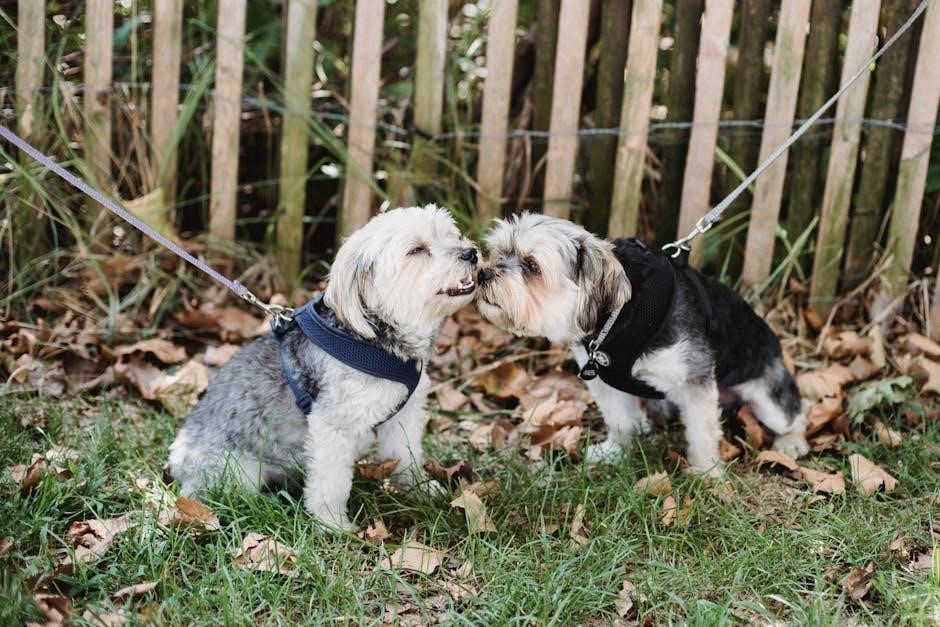
Types of Dog Harnesses
Dog harnesses come in various types, including no-pull, hiking, car, tactical, and step-in or head-in styles, each designed for specific activities and dog lifestyles, offering versatility and functionality.
No-Pull Dog Harnesses
No-pull dog harnesses are specifically designed for dogs that tend to pull on the leash, featuring a front-clip attachment point to help guide their movement gently. These harnesses distribute pulling pressure across the chest and shoulders, preventing choking and offering better control. They often include adjustable straps for a secure fit and padding for comfort. Ideal for training and everyday walks, no-pull harnesses encourage good walking behavior without causing discomfort or stress to your dog. They are a practical solution for active dogs that pull excessively.
Hiking and Adventure Harnesses
Hiking and adventure harnesses are built for durability and comfort during long treks. They typically feature weather-resistant materials, reinforced padding, and multiple attachment points for accessories. These harnesses often include reflective elements for visibility and adjustable straps for a secure fit. Designed for active dogs, they prioritize breathability and flexibility, ensuring comfort on rugged terrains. With features like cargo pockets and sturdy construction, hiking harnesses are perfect for dogs accompanying their owners on outdoor adventures, offering both practicality and reliability in challenging environments.
Car Dog Harnesses
Car dog harnesses are designed to keep your furry friend safe and secure during road trips. They typically feature sturdy construction with metal clips and padded chest plates for comfort. These harnesses often double as walking harnesses, offering versatility. Look for crash-tested options to ensure safety, as they help prevent injury in sudden stops. Adjustable straps and easy-on designs make them convenient for dogs of all sizes. Reflective materials enhance visibility, while quick-release buckles provide hassle-free use, making car harnesses an essential accessory for traveling pets.
Tactical Dog Harnesses
Tactical dog harnesses are built for durability and functionality, ideal for working dogs, training, or active outdoor adventures. They often feature reinforced stitching, heavy-duty materials, and multiple attachment points for gear. Many include Molle systems for adding pouches or accessories, making them versatile for service or field use. Padded areas ensure comfort during long missions, while adjustable straps provide a secure fit. Tactical harnesses are designed to withstand rigorous activities, offering both support and utility for dogs in demanding roles.
Step-in vs. Head-in Harnesses
Step-in harnesses are easy to put on, with leg holes your dog steps into, making them ideal for dogs that dislike head-in styles. Head-in harnesses, like the Ruffwear Front Range, offer better control for strong pullers by guiding the dog’s movement. Step-in harnesses are more comfortable for calm dogs, while head-in styles are preferred for training and managing pulling behavior. Both designs prioritize comfort and functionality, catering to different dog personalities and walking needs, ensuring a secure and enjoyable experience for both the dog and the owner.

Materials and Durability
Dog harnesses are crafted from durable materials like nylon, polyester, and neoprene, ensuring longevity. Padded designs enhance comfort, while weather-resistant options withstand outdoor adventures, supporting active lifestyles.
Nylon Harnesses
Nylon harnesses are durable, lightweight, and inexpensive, making them a popular choice for dog owners. They are easy to clean and come in various styles, offering excellent value. However, nylon lacks breathability, which can cause heat trapping and discomfort for dogs in warm weather. Despite this, they remain a practical option for everyday use, especially for dogs that don’t require heavy-duty support. Their versatility and affordability make nylon harnesses a great starting point for many pet owners.
Polyester Harnesses
Polyester harnesses are known for their durability and water-resistant properties, making them ideal for dogs that enjoy water activities or outdoor adventures. They are lightweight and come in vibrant colors, offering both style and functionality. While they are slightly less breathable than nylon, polyester harnesses are often more form-fitting, providing excellent comfort and support. Their sturdy construction makes them a great choice for active dogs, though they may be less suitable for dogs that require maximum ventilation in warmer climates.
Padded and Neoprene Harnesses
Padded and neoprene harnesses prioritize comfort and durability, featuring cushioned layers for optimal support. Neoprene, a flexible, weather-resistant material, is ideal for active dogs. These harnesses reduce chafing and provide excellent chest and shoulder protection, making them perfect for long hikes or rigorous training. While they offer superior comfort, they may retain heat, so they’re best for cooler climates or shorter adventures. Their robust design ensures lasting performance, making them a great choice for dogs that need extra support and protection during outdoor activities.
Weather-Resistant Materials
Weather-resistant materials like nylon, polyester, and neoprene are designed to withstand outdoor conditions. These durable fabrics repel water, resist dirt, and maintain their structure in wet environments. Ideal for hiking or beach outings, they ensure your dog stays comfortable and dry. Breathable designs prevent overheating, while reinforced stitching enhances longevity. Whether rain or shine, a weather-resistant harness keeps your dog protected and comfortable, making it a practical choice for active pets.

How to Choose the Right Harness
Consider your dog’s size, activity level, and specific needs. Look for adjustable straps, durable materials, and features like padding or reflective details. Ensure proper fit and comfort.
Size and Fit Considerations
Proper sizing is crucial for your dog’s comfort and safety. Measure your dog’s chest and girth using a flexible tape measure. Ensure the harness fits snugly but not too tightly, allowing two fingers to fit beneath the straps. Adjustable straps provide a customized fit, preventing chafing or restricted movement. Regularly check the fit, especially for growing puppies or dogs with changing weights. A well-fitted harness ensures even pressure distribution and prevents discomfort during walks or activities, making it essential for your dog’s overall well-being;
Breed-Specific Harnesses
Different dog breeds have unique body shapes and needs, making breed-specific harnesses a practical choice. For example, barrel-chested breeds like Bulldogs require a harness with a broader chest plate for comfort, while slender breeds like Greyhounds benefit from streamlined designs. Small breeds may prefer lightweight, padded harnesses, while large breeds need durable, heavy-duty materials. Consider your dog’s specific anatomy and activity level when selecting a harness. Brands like Ruffwear and Kurgo offer breed-specific options, ensuring a perfect fit and optimal comfort for your furry friend.
Dog’s Activity Level and Needs
Your dog’s activity level and lifestyle play a crucial role in selecting the right harness. Energetic dogs that enjoy hiking or running require durable, breathable materials and reinforced construction. Calmer dogs may prefer lightweight, padded harnesses for casual strolls. Consider features like weather-resistant fabrics for outdoor adventures or no-pull designs for dogs that tend to tug on the leash. Ensuring the harness aligns with your dog’s energy level and specific needs ensures comfort and safety during any activity.
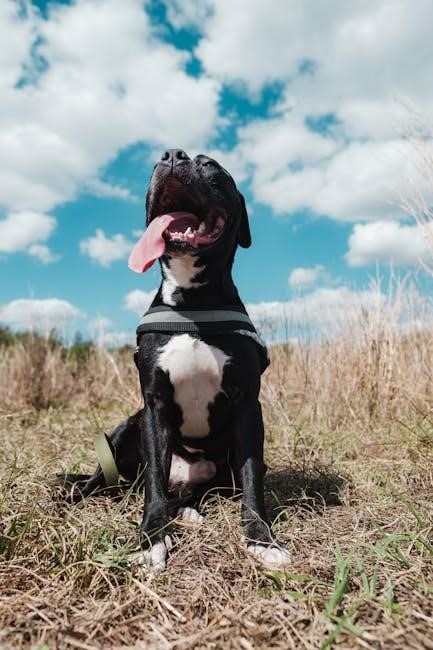
Fitting and Sizing
Proper fit is essential for comfort and safety. Measure your dog’s chest and girth accurately to ensure the harness isn’t too tight or loose, promoting optimal mobility and support.
How to Measure Your Dog for a Harness
To ensure a proper fit, measure your dog’s chest and girth using a flexible tape measure. Wrap it around the broadest part of their chest, just behind the front legs, keeping the tape snug but not tight. Avoid placing it too low or too high, and make sure your dog is standing upright for accurate sizing. Correct measurements are crucial for comfort and to prevent chafing or restricted movement. Always refer to the manufacturer’s sizing chart to match your dog’s measurements precisely.
Adjustable Straps and Custom Fit
Adjustable straps are essential for achieving a tailored fit for your dog. They allow you to tighten or loosen the harness as needed, ensuring comfort and preventing chafing. Properly fitted harnesses accommodate your dog’s unique body shape and movement, while also allowing for growth in puppies. Look for multiple adjustment points to fine-tune the fit, ensuring the harness stays secure without restricting your dog’s range of motion. This feature is especially important for active dogs or those with sensitive skin, providing both comfort and versatility for various activities.
Ensuring Comfort and Avoiding Chafing
Ensuring your dog’s comfort is crucial for a positive harness experience. Look for high-quality, breathable materials like nylon or polyester, which prevent moisture buildup and skin irritation. Padding, especially in chest and shoulder areas, distributes pulling pressure evenly, reducing discomfort. Proper fit is key—harnesses should be snug but not tight, allowing for a full range of motion. Regularly check for signs of chafing or rubbing, and adjust straps as needed. For active dogs, opt for reinforced padding to enhance durability and comfort during extended use. This ensures your dog stays happy and stress-free on every adventure.

Features to Look For
Key features include padding for comfort, reflective materials for visibility, and adjustable straps for a secure fit. Durable materials ensure longevity, while multiple attachment points enhance control and versatility.
Padding and Cushioning
Padded and cushioned dog harnesses provide exceptional comfort, reducing irritation and chafing during extended wear. They distribute pressure evenly, preventing discomfort, especially for dogs that pull or engage in high-energy activities. Neoprene-lined harnesses are particularly effective, offering both support and flexibility. Look for harnesses with breathable padding to keep your dog cool and dry, ensuring long-lasting comfort and enjoyment during walks, hikes, or training sessions.
Reflective Materials for Visibility
Reflective materials on dog harnesses enhance visibility in low-light conditions, such as early morning or evening walks. They ensure your dog is easily seen by others, reducing the risk of accidents. Many top-rated harnesses feature reflective strips or stitching, providing added safety for both you and your pet. This feature is especially beneficial for dogs that tend to wander or for owners who frequent busy areas. Opting for a reflective harness promotes peace of mind and ensures your dog remains visible at all times.
Leash Attachment Points
Leash attachment points on dog harnesses are crucial for effective communication and control during walks. Many harnesses feature both front and back clips, offering versatility for different training needs. Front clips help reduce pulling by guiding your dog, while back clips are ideal for well-behaved dogs. Dual-clip harnesses provide flexibility, allowing you to choose the best attachment point based on your dog’s behavior. Durable, reinforced clips ensure long-lasting performance and safety, making them a key feature to consider when selecting the right harness for your pet.
Adjustability and Customization
Adjustability and customization are key features in dog harnesses, ensuring a secure and comfortable fit for your pet. Adjustable straps allow you to tailor the harness to your dog’s body, accommodating growth or seasonal changes in clothing. Many harnesses also offer customizable options, such as interchangeable patches or personalized tags, adding both functionality and style. Proper adjustment prevents chafing and ensures the harness stays in place during activities, making it a versatile choice for dogs of all sizes and breeds.
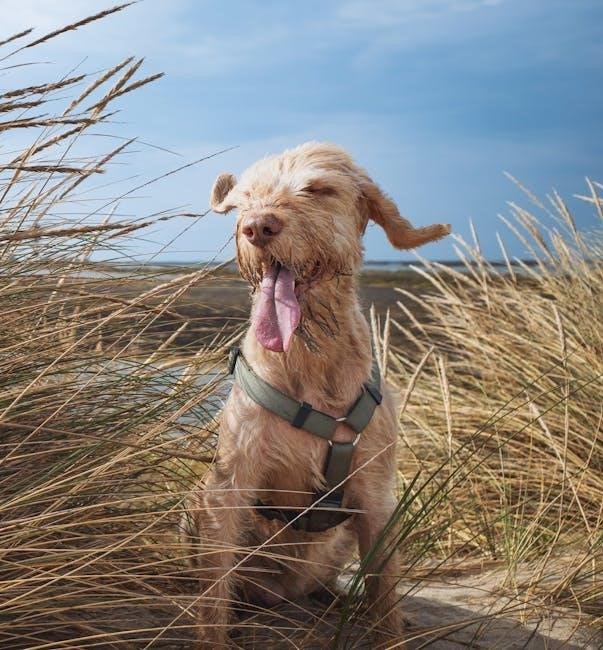
Safety and Training
Dog harnesses enhance safety by reducing neck strain and provide better control during training, making them ideal for dogs that pull or require behavioral guidance.
Using a Harness for Training
A dog harness is an effective tool for training, especially for dogs that pull or exhibit unwanted behaviors during walks. By redistributing pulling pressure across the chest and shoulders, harnesses minimize neck strain, making training more comfortable and controlled. Front-clip harnesses are particularly useful for steering, while dual-clip options offer versatility. Properly fitted harnesses can help teach loose-leash walking and reduce pulling, ensuring safer and more enjoyable outings. They are also ideal for puppies or dogs in obedience training, promoting better focus and behavior.
Preventing Pulling and Choking
Dog harnesses are designed to prevent pulling and choking by distributing pressure evenly across the chest and shoulders, rather than concentrating it on the neck. This makes them especially beneficial for dogs that tend to pull or lunge, as it reduces the risk of trachea injuries. Front-clip harnesses are particularly effective for discouraging pulling, while proper fitting ensures comfort and safety. By minimizing neck strain, harnesses promote a more enjoyable walking experience for both you and your dog.
Safety Tips for Harness Use
Ensure your dog’s harness fits properly to avoid discomfort or restriction. Avoid over-tightening, as this can impede breathing or movement. Opt for weather-resistant materials to withstand various conditions. Reflective elements enhance visibility during low-light walks. Always use a secure leash attachment point for better control. Regularly inspect the harness for wear and tear, replacing it if necessary. Adjust the harness as your dog grows or gains muscle to maintain comfort and safety. Proper use ensures a secure and enjoyable experience for both you and your dog.
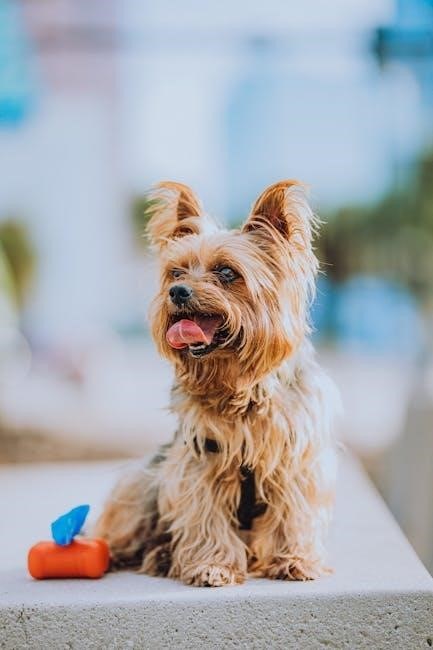
Top-Rated Dog Harnesses
Ruffwear Front Range and Coastal Pet K9 Explorer are top choices for durability and comfort. Rabbitgoo No-Pull and Kurgo Dog Walking Harness excel in control and versatility.
Ruffwear Front Range Harness
The Ruffwear Front Range Harness is a top choice for durability and comfort, ideal for hiking, walking, or everyday use. Its padded chest and belly panels provide excellent comfort, while reflective materials enhance visibility. Designed with dual leash attachments, it offers versatility for training and control. Lightweight and weather-resistant, this harness is perfect for active dogs, ensuring a secure and enjoyable experience for both pet and owner during adventures big or small.
Coastal Pet K9 Explorer Reflective Harness
The Coastal Pet K9 Explorer Reflective Harness is a step-in design offering ease of use and a customizable fit. Its reflective trim ensures visibility during early morning or evening walks. Made from durable nylon, it features adjustable straps for comfort and security. This harness is perfect for dogs that prefer a head-in style, providing a stress-free walking experience. Its lightweight construction and weather-resistant materials make it ideal for everyday adventures, ensuring both safety and comfort for your dog.
Rabbitgoo No-Pull Pet Harness
The Rabbitgoo No-Pull Pet Harness is a popular choice for dogs that tend to pull during walks. Designed with a front-clip system, it helps guide your dog gently without causing discomfort. The harness features soft, cushioned padding for enhanced comfort and an adjustable chest strap for a secure fit. Its durable construction makes it suitable for daily use, while the vibrant colors and reflective details improve visibility. Available in various sizes, it’s an excellent option for training and ensuring a pleasant walking experience for both you and your dog.
Kurgo Dog Walking Harness
The Kurgo Dog Walking Harness is a durable and versatile option designed for comfort and control. Its padded chest plate ensures even pressure distribution, making it ideal for large dogs. Adjustable straps provide a customizable fit, while the sturdy construction withstands regular use. Suitable for daily walks, hikes, and even car rides, this harness offers practicality and ease of use. Its sleek design and robust materials make it a reliable choice for active dogs, ensuring both safety and comfort during outdoor adventures.
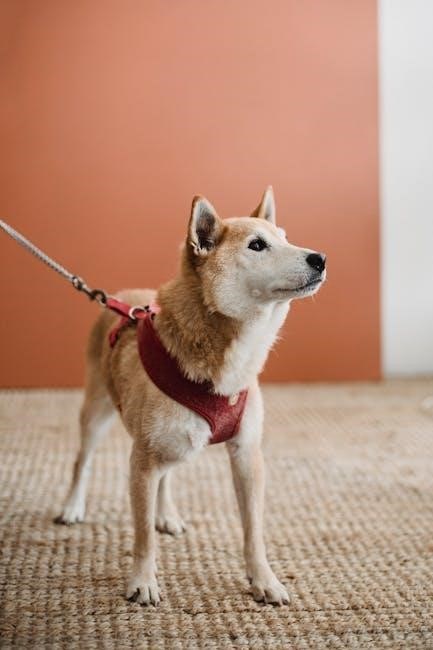
Common Mistakes to Avoid
Incorrect sizing and using the wrong harness type are common errors. Always measure your dog accurately and choose a harness suited to their activity level and build.
Incorrect Sizing
Incorrect sizing is a common mistake when selecting a dog harness. A harness that is too tight can cause discomfort, chafing, and restrict your dog’s movement, while one that is too loose may allow your dog to slip out. Proper sizing ensures optimal comfort and safety. Always measure your dog accurately, taking into account their breed, age, and activity level. Adjustable straps can help achieve a secure and comfortable fit, preventing issues during walks or adventures.
Using the Wrong Harness Type
Using the wrong harness type can lead to discomfort, reduced control, and even safety risks for your dog. For example, a no-pull harness is ideal for dogs that tug on the leash, while a car harness is specifically designed for safe travel. Choosing a harness unsuitable for your dog’s behavior or activity can result in poor performance and potential hazards. Always match the harness type to your dog’s needs, whether for walking, hiking, or car rides, and consider their size, strength, and temperament. Research and expert advice can help ensure the best fit.
Neglecting Adjustability
Neglecting adjustability is a common mistake that can compromise your dog’s comfort and safety. A poorly fitted harness may cause chafing, restrict movement, or even lead to escape attempts. Adjustable straps ensure a snug yet comfortable fit, preventing discomfort during walks or activities. Failing to adjust the harness properly can result in poor performance and potential hazards. Always ensure the harness is tailored to your dog’s body, with adjustable points like chest plates and shoulder straps. Regular checks and adjustments are essential for optimal comfort and safety.
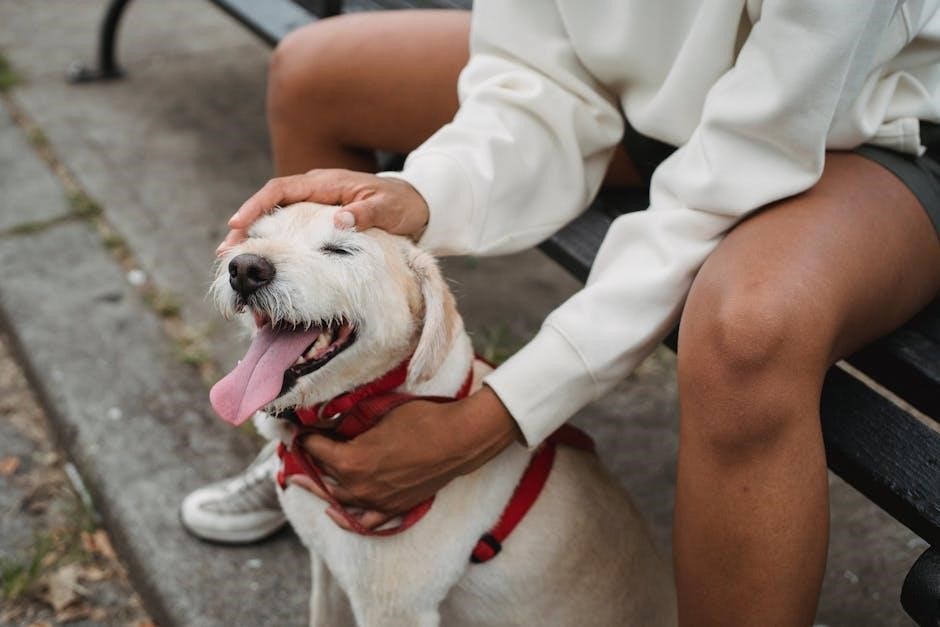
Frequently Asked Questions
Common questions include introducing a harness to your dog, whether puppies can use them, and if harnesses are better for pulling dogs. These FAQs guide optimal harness use.
How Do I Introduce a Harness to My Dog?
Introducing a dog harness should be done gradually to ensure comfort and acceptance. Start by letting your dog see and smell the harness, associating it with positive reinforcement like treats. Once your dog is comfortable with the harness’s presence, put it on indoors for short periods, rewarding calm behavior. Ensure a proper fit by adjusting straps to prevent discomfort. Finally, take your dog for a walk, using familiar leashes and treats to maintain positivity. Patience and consistency are key to a successful transition.
Can Puppies Use Harnesses?
Puppies can safely use harnesses, as they protect their delicate necks and prevent trachea strain. Introducing a harness early helps puppies get accustomed to wearing one, making walks easier as they grow. Choose a lightweight, adjustable harness designed for puppies, ensuring it fits properly without being too tight. Start with short sessions indoors, letting your puppy explore while wearing it. Positive reinforcement, like treats, can help your puppy associate the harness with positive experiences. This helps build confidence and makes future outings enjoyable for both you and your puppy.
Are Harnesses Better for Pulling Dogs?
Harnesses are highly recommended for dogs that pull, as they distribute pulling pressure across the chest and shoulders, reducing neck strain and discomfort. Unlike collars, harnesses provide better control and discourage pulling behavior. Front-clip harnesses are particularly effective, as they guide the dog’s movement gently. For aggressive pullers, no-pull harnesses with reinforced materials offer optimal support. Always choose a durable, weather-resistant harness to ensure long-term comfort and safety for your dog, especially during active walks or training sessions.
Choosing the right dog harness ensures comfort, safety, and control. Consider your dog’s needs, size, and activity level for the best fit. This guide helps you make an informed decision, ensuring a happy and healthy walking experience for your furry friend.
Final Thoughts on Choosing the Best Harness
When selecting a dog harness, prioritize your dog’s comfort, safety, and specific needs. Consider their size, breed, and activity level to ensure proper fit and functionality. Opt for durable materials like nylon or polyester, and look for features such as padding, reflective elements, and adjustable straps. A well-chosen harness enhances walking experiences, prevents discomfort, and provides optimal control. By balancing comfort, functionality, and durability, you can find the perfect harness for your furry companion, ensuring happy and safe adventures together.
